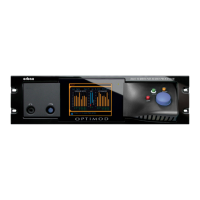3-48
OPERATION ORBAN MODEL 8685
put level is changed. “10” is the softest knee, where the transition starts 6 dB below
B
ASSCLIPTHRESH setting and occurs gradually. The factory default setting is “7.6.”
(See Figure 3-1.)
Final Limit Drive
controls (AGC and MB) adjust the level of the audio driving the
low-IM look-ahead limiters that the 8685 uses to control fast peaks, thereby adjust-
ing the peak-to-average ratio of the processed audio. The F
INAL LIMIT DRIVE controls
primarily determine the loudness/distortion trade-off.
Only one of the two L
IMIT DRIVE controls is active at a given time. Depending on the
setting of the S
URROUND OUTPUT SOURCE and 2.0 OUTPUT SOURCE controls in the ac-
tive Setup, a given processing channel’s look-ahead limiter receives either the AGC’s
output or the multiband compressor/limiter’s output. This determines which L
IMIT
DRIVE control is active.
Turning up the F
INAL LIMIT DRIVE control drives the look-ahead limiter harder, reduc-
ing the peak-to-average ratio at the 8685’s output and increasing the loudness at
the consumer’s receiver. When the amount of limiting is increased, the audible in-
termodulation distortion caused by limiting increases, even though special algo-
rithms minimize the increase compared to less sophisticated designs. Lower settings
reduce loudness, of course, but result in a cleaner sound.
Note that the active FINAL LIMIT DRIVE control is cascaded with a hidden
gain control whose value is determined by the active D
IALNORM setting.
See Low-IM Look-Ahead Limiter 3-13.
Transient Enhance is mainly useful in mastering. This control allows you to insert
an audio delay in the sidechain of the five-band compressor. By delaying the gain
control signal, this allows attack transients to pass through the multiband compres-
sor uncompressed, which can increase punch. There is a tradeoff between this con-
trol and the activity of the look-ahead limiter, which will have to eliminate attack
transients exceeding the look-ahead limiter’s threshold. For any material, there will
be an optimum setting for the T
RANSIENT ENHANCE control that provides the most
punch without triggering look-ahead limiter artifacts.
The Two-Band Structure
The Two-Band structure consists of a slow two-band gated AGC for gain riding, an
equalization section, a gated two-band compressor, and a low-IM look-ahead lim-
iter. A CBS Loudness Controller, which is primarily useful for sound-for-picture appli-
cations, can be activated to control subjectively perceived loudness.
The 8685’s Two-Band Structure can be made phase-linear throughout to maximize
sonic transparency. However, you can also choose an allpass crossover structure (see
AGC
CROSSOVER on page 3-44).
The Two-Band structure has an open, easy-to-listen-to sound that is similar to the
source material if the source material is of good quality. We recommend using it
when you want to preserve the spectral balance of the source material while not

